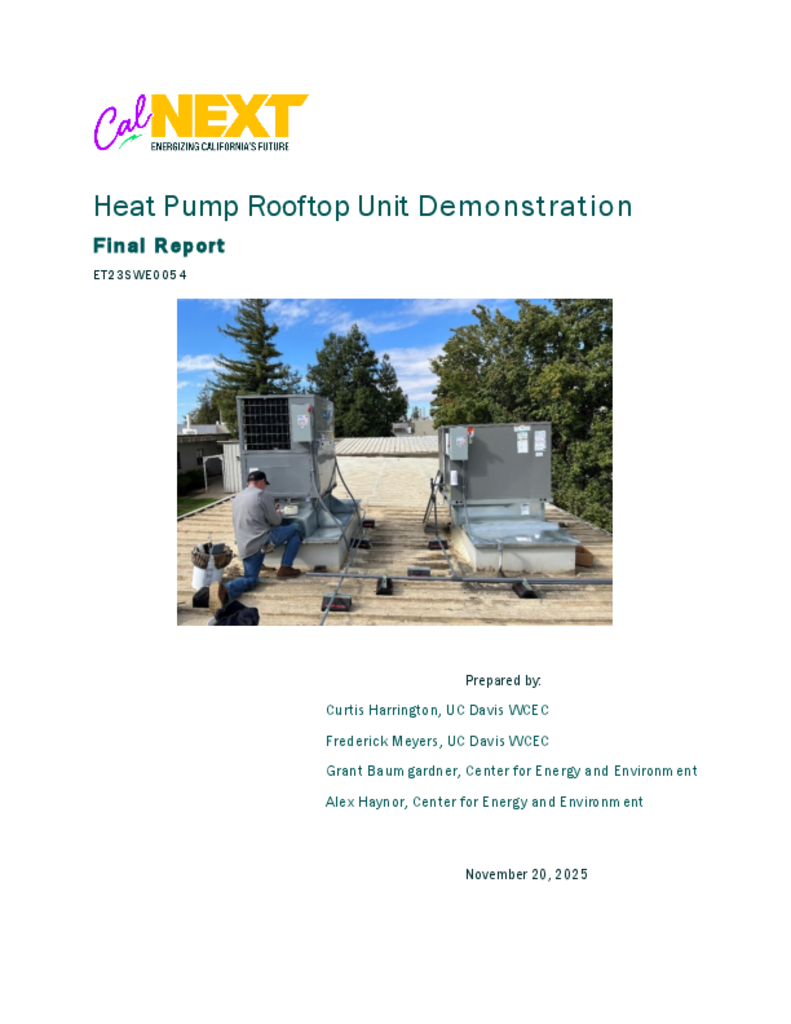ET23SWE0054 - Heat Pump Rooftop Unit Demonstration
The goal of this project is to understand the potential of heat pump rooftop unit (RTU) technology to electrify and decarbonize existing commercial building heating loads. Rooftop units are particularly ripe for market transformation as they are ubiquitous in the commercial sector with decades of little to no advancement and innovation. Because heat pumps move heat into buildings from surroundings, they do not require onsite combustion of fuel and can deliver heating at efficiencies in excess of 100%. This means they could achieve enormous end-use energy savings and carbon emissions reduction relative to the incumbent gas fired RTUs.
Significant research and field testing have already been performed on residential applications of air-source heat pumps (ASHPs). However, the limited use of heat pumps to date in the commercial roof-top unit (RTU) market has meant that there is little available third-party data to demonstrate the performance characteristics as well as non-energy benefits of heat pump RTUs. There is an urgent need to address this gap in the available data as consumers, utilities, and governments seek ways to significantly reduce emissions from space heating in a commercial building market which has a high penetration of existing RTUs. Heat pump RTUs offer an ideal solution for existing buildings because they are drop-in replacements for existing RTU systems, reducing installation time and cost.
For this project, we will characterize the energy consumption of heat pump RTUs using data collected from monitoring of actual equipment performance. We know that unit controls, building characteristics, and weather patterns have a major influence on actual energy consumption, so this information will provide a significant improvement relative to energy consumption estimates based only on equipment performance ratings and manufacturer claims. In addition, we will monitor space conditions to assess the ability of heat pump RTUs to maintain comfortable indoor environments for building occupants.
The monitored heat pump equipment will include a high-efficiency RTU, ideally with variable speed compressor technology, and a standard efficiency heat pump rooftop unit with single or two stage compression. These heat pumps will likely be in the 3-5 Ton range. We will select RTUs that can be procured through local market channels and delivered for installation before the beginning of the planned monitoring period. In case multiple manufacturers offer products meeting these criteria, the lowest cost qualified product will be selected. The capacity of the RTUs evaluated will be determined based on the heating and cooling loads of the laboratory building zones through the project. A conventional gas-pack RTU will be monitored to serve as a baseline for comparison. These systems will be instrumented to measure their overall power and energy consumption, delivered heating and cooling capacity, and coefficient of performance (COP). Additional instrumentation will allow us to monitor detailed aspects of the equipment’s performance such as controls strategies and defrost performance. Finally, we will document key installation and design characteristics for these systems to ensure they can deliver benefits to building owners, occupants, and utilities alike.
Packaged rooftop units are estimated to provide space conditioning for 75% of commercial building space in California and represent a significant opportunity for electrifying space heating loads using heat pump technology. Though space conditioning heat pumps are a keystone technology in California’s plans to decarbonize, there are still uncertainties in the market about what heat pump technology to select for a particular application and the benefits of different features offered by heat pump products.
This paper presents the findings from a field demonstration project that evaluated the performance of two 3-ton rooftop heat pump units to assess the impact of electrification retrofits in commercial buildings. The study collected primary data on a standard-efficiency and a high-efficiency heat pump, alongside a baseline gas-fired unit. Detailed monitoring allowed performance data to be normalized to local weather, ensuring accurate comparisons.
The high-efficiency unit featured inverter-driven compressor technology, enabling variable capacity operation to match building load. This modulation capability resulted in longer cycle durations and improved overall efficiency. Notably, the advanced features of the high-efficiency unit allowed it to operate without supplementary electric resistance heating, maintaining occupant comfort while reducing peak demand by over 50%. This reduction in peak demand can facilitate heat pump installations using existing electrical infrastructure for gas-fired rooftop units, significantly lowering installation costs.
The high-efficiency heat pump demonstrated approximately 7% higher overall efficiency compared to the standard unit which was lower than expected based on the 30% higher rated performance. Analysis of defrost cycles revealed that the high-efficiency unit’s control strategies avoided comfort issues during defrost events by temporarily shutting off the supply fan to avoid blowing cold air on occupants.
Overall, the results highlight the advantages of advanced heat pump technologies in electrification retrofits, including reduced installation and operating costs, improved energy performance, and enhanced occupant comfort.

